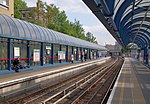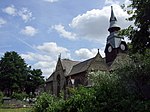Poplar Baths
Buildings and structures in the London Borough of Tower HamletsPoplar, LondonSwimming venues in EnglandUse British English from February 2018

Poplar Baths on the East India Dock Road in Poplar, London is a former public bath house and Grade II listed building that was constructed in 1933 and closed to the public in 1988. The Baths are adjacent to All Saints DLR station. A campaign to restore the baths won the support of Tower Hamlets Council in 2010 and the construction company Guildmore was appointed to complete the works to create a new leisure centre incorporating a swimming pool, gymnasium and affordable housing on adjacent land. The site reopened in July 2016.
Excerpt from the Wikipedia article Poplar Baths (License: CC BY-SA 3.0, Authors, Images).Poplar Baths
Poplar Bath Street, London Poplar
Geographical coordinates (GPS) Address External links Nearby Places Show on map
Geographical coordinates (GPS)
| Latitude | Longitude |
|---|---|
| N 51.5109 ° | E -0.0141 ° |
Address
Poplar Public Baths
Poplar Bath Street
E14 0HE London, Poplar
England, United Kingdom
Open on Google Maps








